We get it. Choosing the right project management tool for the type of work you’re doing and the teams doing it can be massively overwhelming. What features do you need? Is the platform easy to navigate? Does it integrate with the rest of your tech stack? And….how much does it cost? (Gulp!)
There’s a lot to consider, and you don’t want to melt your brain trying to figure it all out. That’s why we’ve compiled this (updated) list of top project management software tools to plan, track, and deliver great projects.
Get started using our handy filters to find the perfect project management tool for you.
Find the right project management tool for your needs
Toggl Plan
From $5 per user/mo (Free plan available)
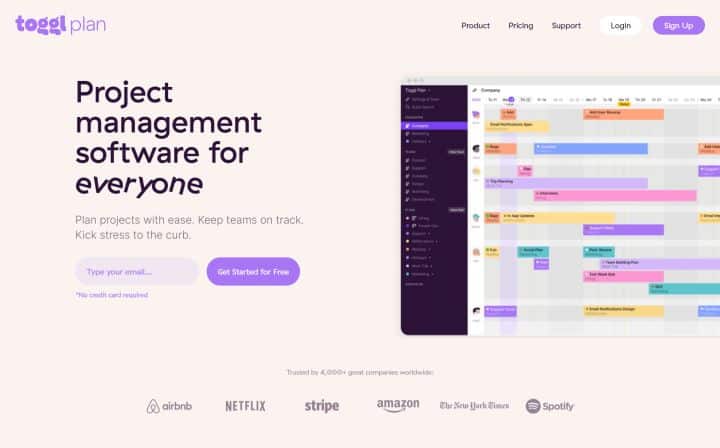
Toggl Plan is a beautifully simple project management tool. Its simple, drag & drop, user-friendly interface makes it a breeze to plan projects, get tasks done, and manage team workloads.
It integrates seamlessly with the likes of Slack, GitHub, and Google Calendar, and offers task templates so you can get up and running quickly. There’s also a handy Chrome extension to add tasks from anywhere in just a few clicks.
Features
- Plan projects with timelines and milestones
- Get a clear visual overview of who’s doing what, and when
- Use timelines, boards, and custom task workflows that adapt to your way of working
- Collaborate with multiple team members, sharing documents, files, and updates
- Plan recurring weekly, monthly, and fortnightly tasks
- Track time spent on each task with the Toggl Track integration
- Improve task completion quality with task checklists
Is Toggl Plan right for you?
Toggl Plan is just right if you need a simple, affordable, and visual project management tool. There’s almost no learning curve. And, your team will actually enjoy using it every day. Note that it may not be the best fit for large program or portfolio management.
Pricing
The free plan is great for solo up to five users, including access to the mobile app and Toggl Track integration. Capacity plans start at $5 per user/mo, unlocking features such as task estimate, team capacity planning, and time off.
Reviews
- “Toggl Plan offers several features that make it great for project management and team collaboration, such as visual planning, a user-friendly interface, task management, customization, and time tracking.” — Isaac, Sport Writer
- “Toggl Plan is thought for its intuitive interface and easy learning curve. But it does not allow multiple assignments to one job or sub-jobs with separate activities. This can be a drawback for complex projects with shared owners.” — Ankita, Small Business Owner
Trello
From $5 per user/mo (Free plan available)
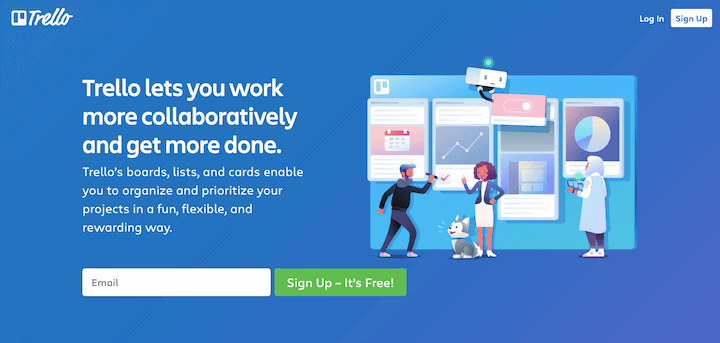
Trello is a board-based task management tool. It’s great for teams that use Kanban or Scrum to manage task-based projects and workflows, and those who value simplicity and ease of use. Trello’s premium plans also include enterprise-level security, AI, and integrations to some of the world’s most popular tools, including Slack, Gmail, and Jira.
Features
- Visually manage tasks with Kanban boards and calendars
- Link file attachments and checklists to tasks
- Add due dates & custom fields to tasks
- Use Atlassian AI to create tasks and automate workflows
- Use apps for Windows, Mac, and Android
- Invite guests to collaborate on tasks and projects
- Enterprise-level security with two-factor authentication
Is Trello right for you?
Individuals/teams like Trello for its simple task management. However, other project management tools are a better option if you need project planning, resource management, or workload management features.
Pricing
The free plan comes with unlimited task cards and up to 10 boards. Paid plans start at $5 per user/mo introducing customizations, increased storage, and guests.
Reviews
- “After five years of use, Trello remains one of the most user-friendly and visually intuitive project management tools I’ve worked with. The drag-and-drop Kanban board style makes it effortless to organize tasks and workflows, whether for solo projects or team collaboration.” – Mohammad, Co-Founder
- “It doesn’t have many themes to customize the dashboard, and I don’t really like that I can’t chat with my colleagues without having to pay an additional add-on.” – Morat, Web Developer
Asana
From $10.99 per user/mo (Free plan available)
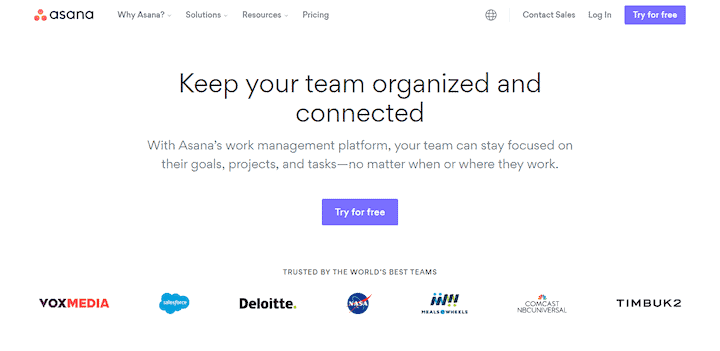
Asana is a complete project management system, combining task lists, timelines, and boards to get work done. In recent years, it’s also evolved to include goal-setting, resource management, and Asana AI to turbocharge your productivity. In addition, it integrates with other communication and collaboration tools and has apps to keep you working on the go.
Features
- See the bigger picture with a complete timeline view
- Keep teams on track with intuitive task management
- Workload management for capacity planning
- Custom workflow management
- Unlimited free guests to maximize collaboration
- Automatically generate beautiful status updates
- Track at program and portfolio level too
Is Asana right for you?
Users love Asana for its all-in-one project management power, range of features, and integrations. But for a small team, you may find it overly complex and expensive, especially if you exceed the relatively small 100 MB storage limit on the free Personal plan.
Pricing
The free Personal plan offers the chance to collaborate with up to 10 teammates. Paid plans start at $10.99 per user/mo, unlocking access to timelines, real-time dashboards, and workload management.
Reviews
- “Asana’s transparency is a game-changer—everyone can see each team member’s progress on a project. I particularly appreciate the task dependency feature, where my tasks activate only after preceding ones are completed, eliminating the need for constant email updates to track project status.” – Alabama, Director
- “I’ve been in project management for over 20 years, and the job is difficult enough without adding a complex piece of software. I would rather keep it simple, I don’t need a project to learn software so I can run a project on it.” – David, IT Engineer
monday.com
From $9 per seat/mo (Free plan available)
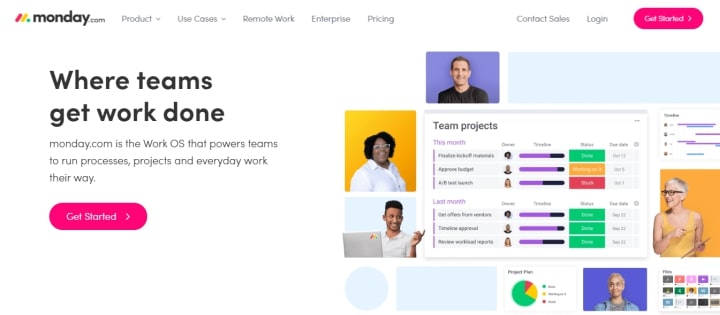
monday.com is one of the world’s most popular project management platforms. It offers dedicated products like monday work management that enable teams or entire companies of any size or type to manage their project work in whatever way makes sense to them. It’s a highly collaborative space with a wealth of task management, reporting, and communication features that streamline workflows and keep everyone aligned.
Features
- Manage projects and tasks using Kanban boards, tables, lists, calendars, or Gantt views
- Ready-made project templates make it easy to get started
- Track time spent on each task and measure productivity
- Manage guest access with unlimited free ‘viewers’
- Add automation to speed up workflows
- Advanced analytics dive into profitability and project performance
Is monday.com right for you?
monday.com is right for almost every team project, although paid plans start at a minimum of three seats. This may be a dealbreaker for freelancers looking for uber-cheap project management tools.
Pricing
monday.com has a free plan for up to 2 users. Paid plans then start from $9 per seat/mo, ranging up to Pro and Enterprise packages for larger teams.
Reviews
- “monday.com tools make project management and working between sales and operations a more efficient and smoother process. I use monday.com every day. I can easily check on progress on a project without having to wait for an update from the Project Manager. ” – Jena, VP Account Management
- “monday.com’s paid plans are expensive for startups, especially compared to competitors who offer more generous discounts or freemium options. This lack of affordability feels like a missed opportunity for them to support the startup community.” – Sandy, Founder
Jira
From $7.53 per user/mo (Free plan available)
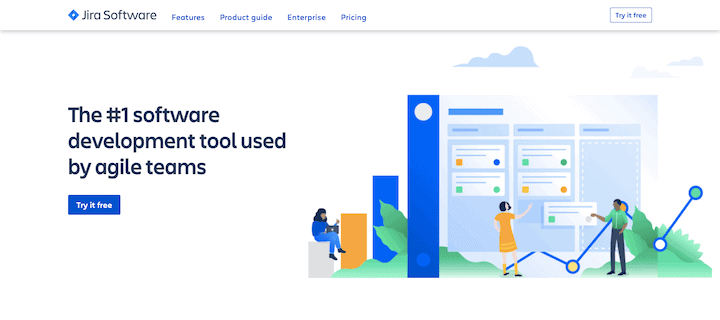
Jira claims to be the number one software development tool for agile project teams, and it’s good a pretty good case for that claim. The tool streamlines software releases with its Issue-based design and workflows, whilst integrating with the tools developers use already, such as Confluence, GitHub, and Bitbucket.
Features
- Manage development to-do lists with bug management
- Oversee product backlogs, lists, boards, and calendar views
- Collaborate with external guests
- Enterprise security with IP whitelisting
- Cross-team dependency tracking and resource planning
- Automate global and multi-project tasks
- Integrates with tools like Dropbox, AdobeXD, and Figma
Is Jira right for you?
Software teams love Jira for its simple view of boards, collaborative dashboards, and bug management. However, creative and marketing teams often use other simple project management tools due to their flexibility and more engaging user interface.
Pricing
The free plan allows up to 10 users, providing you with access to features such as Scrum and Kanban boards, backlogs, and agile reporting. Paid plans start at $7.53 per user/mo adding in additional storage, automation, and external collaborators.
Reviews
- “Jira’s project management tools are amazing. Their entire UI is very easy to use and visually appealing. They support both, kanban and scrum boards, which is a big win as some projects require one while others require the other. ” – Srivishnu, Developer
- “It is overengineered. It is hard to understand how it all ties together because it is overengineered to a point where the usability suffers. Jira should aim to be simpler.” – Siddharth, Product Lead
Microsoft Project/Planner
From $10 per user/mo (Free Planner app available with O365)
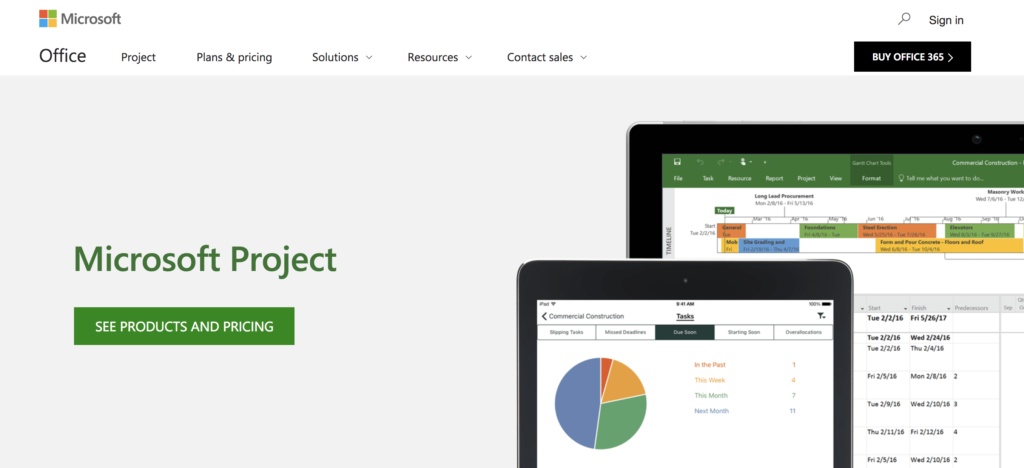
Microsoft Project has the power to manage everything from small tasks to much more complex projects. Its recent integration with Office365 Planner provides extended functionality for different use cases. With full MS Project, users can harness the power of dependency tracking, resource management, and forecasting to map out every step of their project journey.
Features
- Simple list, board, and calendar-based task management with O365 Planner
- Create a holistic view with timeline planning
- Task management and sub-tasks to keep teams on track
- Manage workload and project budgets with timesheet tracking
- Integrates with collaboration software like Microsoft Teams
- Utilize PowerBI for detailed reporting
Is Microsoft Project right for you?
Project managers with technical project management needs, in large corporate companies, often benefit from the power of Microsoft Project. However, for simpler projects that need collaboration, you may find MS Project too complex, opting for Microsoft’s Planner, or another tool instead.
Pricing
Microsoft Project does offer a free plan for O365 Planner, if you have an Office 365 subscription. If not, paid plans start at $10 per user/mo. Enterprise-level features, such as timesheets, demand management, and Copilot AI are available only in top-tier plans.
Reviews
- “It is easy to set up a Project Plan using templates provided in MS Project. Most project managers across industries understand reports/project plans generated from MS Project, whether or not they have used the software before. ” – Alex, Independent Consultant
- “The software is primarily designed for large-scale projects with complex requirements. For small-scale projects or those with simpler workflows, Microsoft PPM might feel overly complex and feature-heavy.” – Mohammed, Project Manager
Basecamp
From $15 per user/mo (Free plan available)
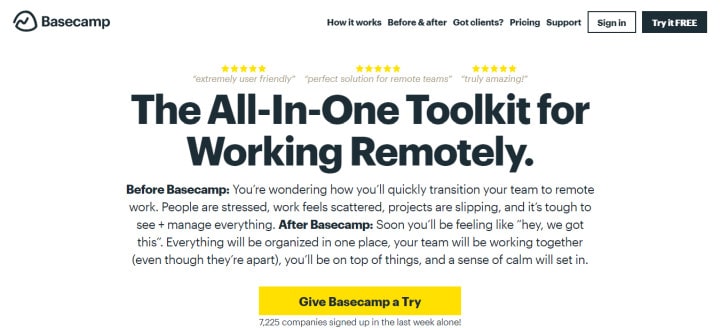
Basecamp is a design-led project management tool popular with creative agencies that need to block out the noise. Basecamp’s simple online project management software is aimed at smaller, ‘hungrier’ businesses, focusing on clean visuals to simplify the project process. There are no Gantt charts, but instead, Basecamp centers around tasks, docs, chats, schedules, and boards to help you and the team collaborate in a way that works for you.
Features
- Manage project tasks with intuitive to-do lists, chats, and boards
- Automatically schedule events and client check-ins
- Collaborate through message boards and group chat
- Invite clients into Basecamp for instant collaboration
- Use Mission Control to keep an eye on your projects and see which are heading off track
- Premium support ensures teams can stay working 24/7
Is Basecamp right for you?
Project managers in the creative, digital, and web spaces love Basecamp’s approach to client collaboration. Those who need more detailed project timelines, dependencies, or resource planning may find Basecamp limiting.
Pricing
Basecamp offers a free plan, which is limited to one project and 1GB of data. However, the paid plan starts at $15 per user/mo with unlimited projects. There’s also Basecamp Pro, which gives you unlimited users for just $299 per month (fixed fee), which is very cost-effective for large agencies.
Reviews
- “Basecamp has been an incredibly useful tool for managing tasks, collaborating with my team, and staying organized. The intuitive interface makes it easy to track project progress, share updates, and communicate effectively.” – Priya, Social Media Manager
- “While it is a good task manager, it is not the best project manager on the market. It does not make longer-term projects or process-intensive work easier, since its systems don’t have many features beyond basic task management.” – Verified User, Research
Teamwork
From $10 per user/mo
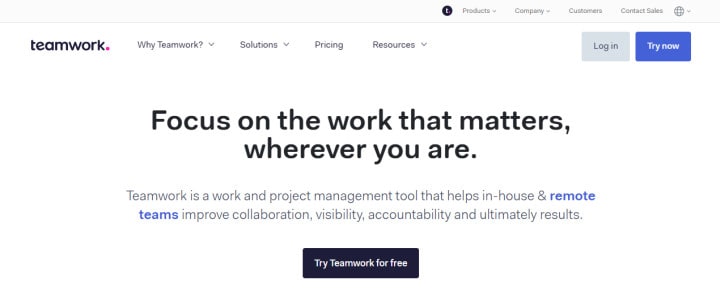
Teamwork is another agency/client-focused project management tool that’s great for teams focused on optimizing resources to maximize profitability. As the name suggests, the tool is all about collaboration, utilizing boards, templates, chat, automation, and client feedback to save time and effort when delivering at speed!
Features
- Project templates to standardize project governance and speed up delivery
- Task Boards give visibility on team progress
- Keep team optimization high with workload management
- Keep track of work completed with timesheet tracking
- Intuitive dashboards to keep sight of team progress
- Retainer management for boosting client profitability
Is Teamwork right for you?
Agencies especially love Teamwork for the collaborative feature-set, timesheet management, and focus on profitability. But for smaller teams, the tool might feel overkill with no free plan and a 3-user, $10 per person start fee.
Pricing
There is no free plan with Teamwork, just a 14-day free trial. After that, it’s $10 per user/mo to start with, with ‘Scale’ packages above $50 per user/mo for the most advanced features.
Reviews
- “I would recommend Teamwork to a friend or colleague. The Board view is fantastic for getting a clear picture of where everything stands, and the time tracking feature helps me when it comes to monthly gathering of billable hours for a project and where it stands against our estimated times.” – Brandy, Solutions Engineer
- “The interface is good, but not as good as I have seen with other products. It takes a little time to get used to the interface, but once you do, then it becomes easier to manage and control project tasks.” – Mark, Senior Consultant
Cascade
Pricing is by request (Free plan available)
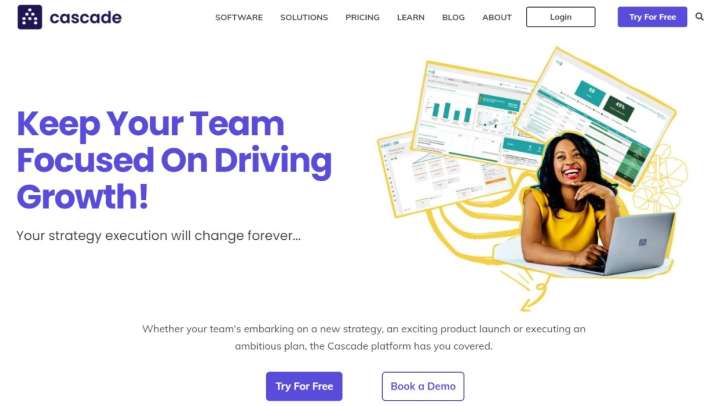
Cascade is a strategy planning platform to plan, execute, and track your strategy implementation. While less focused on day-to-day projects and tasks, users can create strategic plans, manage goals, projects, and KPIs, track performance with dashboards, and manage team member performance.
Features
- Drag and drop strategic planning & execution
- Manage team objectives, projects, and KPIs with ease
- Manage everyday tasks with confidence that they link back to the objectives
- Use Dashboards & Snapshots to analyze your team’s performance
- Integrations bring your KPI data together in one place to drive growth & results
Is Cascade right for you?
Enterprise businesses will find Cascade useful for goal setting and executing strategic initiatives. But for smaller teams or hands-on delivery teams, Cascade won’t have what you need to get things done.
Pricing
Cascade has a free plan for up to four users. After that, its OKR, Essentials, and Enterprise plans are on a quote-only basis.
Reviews
- “Cascade has played a huge role in getting our company aligned on project and strategy governance/management. It is easy to use and laid out in a way that makes it easy to visualize the company’s priorities.” – Charles E, Role Unknown
- “Cascade isn’t primarily designed to be a Project Portfolio Management software, and when we sometimes use it to that end it can become more cumbersome.” – Carson, Strategy Consultant
Zoho Projects
From $5 per user/mo (Free plan available)

Zoho’s suite of products is praised worldwide for its flexibility, customization, and ease of use – and, its project management solution is no different. Perfect for enterprise project management, Zoho Projects provides an integrated take on timeline management, alongside features for workflow automation and customization.
Features
- Track critical and dependent tasks through the timeline
- Integrate apps such as Google Drive and Slack
- Deliver on the go with the Zoho Projects app
- Track project costs with integrated timesheet management
- Large template library gets you up and running quickly
- Zoho’s feed and chat functions make it easy for distributed teams to collaborate
Is Zoho Projects right for you?
If you already use other Zoho tools or need a highly customizable solution, Zoho Projects is a no-brainer. However, those with simpler needs might find the tool overwhelming and clunky to use.
Pricing
The free plan allows up to five users and three projects. Paid plans start at $5 per user/mo, layering in additional features such as time tracking, templates, and customization.
Reviews
- “The premium version offers a lot of features that has helped in making project management very easy. It offers a wide range of features including task management, time tracking, resource management, and collaboration tools.” – Greejith, Project Manager
- “So many modules have similar capabilities but you have to go to a completely separate module to find the one that was necessary for that project. I also felt that even though I could email the support team, it was not ideal in the time it took to resolve issues.” – Jessica, Customer Support
Wrike
From $10 per user/mo, billed annually (Free plan available)
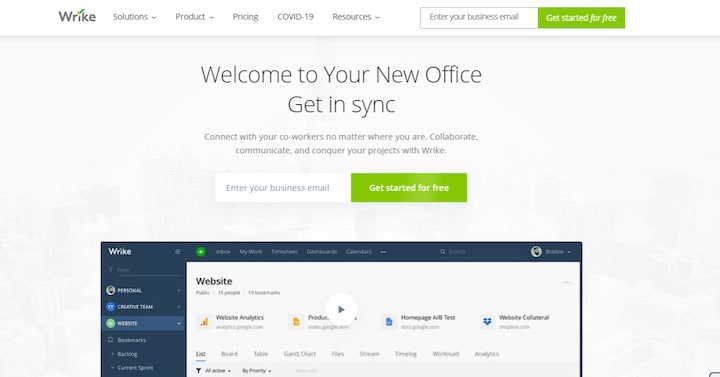
Wrike combines stacks of project management functionality with a clean user interface and Klaxoon’s visual collaboration technology. This gives you everything you need to map out your project timeline, manage resources, track tasks, and incubate new and fresh ideas. In addition, it also comes with enterprise-level security features.
Features
- See the bigger picture with Wrike’s timeline
- Manage your next sprint’s tasks with Kanban boards
- Track team capacity with resource utilization charts
- Keep your data safe with full enterprise encryption
- Use Wrike’s inbuilt whiteboard software, Klaxoon, to collaborate on ideas
- Take Wrike on the go with mobile and desktop apps
Is Wrike right for you?
Those who need a tool to cover project management at all levels will love Wrike. But with so many features, the learning curve can be steep, especially for small, inexperienced teams.
Pricing
The free plan has basic project management features for unlimited users. Paid plans start at $10 per user/mo, adding additional features, enhanced storage, and onboarding support.
Reviews
- “I’ve really enjoyed using Wrike — it’s been a smooth transition from our previous application. Like any platform, there’s a bit of a learning curve at first, but overall it’s been a great experience, and I’m a big fan of how it supports day-to-day project management.” – Abbey, Media Planner
- “The system is overly complex and not user-friendly, making it difficult to work with on a day-to-day basis. While the software may be well-suited to certain types of projects, in other cases it can actually complicate management and hinder progress.” – Verified User, Engineering
Workzone
Pricing is by request

Workzone is a well-rounded project management tool built for marketing, creative, and operations teams. It comes with all the features you’d expect, such as project management, task tracking, timesheets, and resource management, with unlimited support helping teams to onboard to Workzone’s way of working.
Features
- Plan project timelines using Gantt charts and calendars
- Ready-to-import project templates
- Manage approvals and proofing with file sharing
- Time-tracking and resource management
- Manage resources with cross-task and cross-project dependencies
- In-app design markups and collaboration
- SSO & MFA for large enterprise organizations
Is Workzone right for you?
Workzone gets many things right and is great for creative teams. However, its price plans may be too expensive for some teams, especially those with less than five users.
Pricing
Workzone’s pricing is available on a request-only basis. There are three plans (Team, Professional, and Enterprise) with a five-user minimum.
Reviews
- “Workzone’s project management platform is easy to use and setup. It is web-based which means it can be accessed from anywhere. The platform works well for organizations of all size.” – Bess, Informatics Trainer
- “Workzone doesn’t really align with many other online systems that allow a lot of integrations with other tools and customized reports. The tool really only works if you follow their work pattern.” – Verified User, Training
Smartsheet
From $9 per user/mo

Having evolved from an Excel-like interface, Smartsheet offers a range of project management features such as timeline planning, resource management, and task tracking. It integrates with many household names, has powerful reporting, and boasts that teams can get up and running 60x faster thanks to its project templates.
Features
- Map out each project phase with the timeline plan
- Create all-in-one dashboards to see progress at a glance
- Keep a view of tasks with Smartsheet’s boards
- Deliver what matters through comprehensive resource management
- Track team costs to avoid going over budget
- Use project templates to get up-and-running instantly
- Scale to project, program, and portfolio level
Is Smartsheet right for you?
If you’re into cells and grids, and love the familiarity of an Excel-style interface, Smartsheet is definitely worth a look. Although many of its features require more expensive plans, and require increased training and onboarding costs, too.
Pricing
Smartsheet doesn’t offer a free plan. Its ‘Pro’ plan starts at $9 per user/mo, with higher plans including more features, unlimited guest access, and increased storage.
Reviews
- “Workzone’s project management platform is easy to use and setup. It is web-based which means it can be accessed from anywhere. The platform works well for organizations of all size.” – Bess, Informatics Trainer
- “Workzone doesn’t really align with many other online systems that allow a lot of integrations with other tools and customized reports. The tool really only works if you follow their work pattern.” – Verified User, Training
Venturz
From $0 per user/mo (Free plan available)
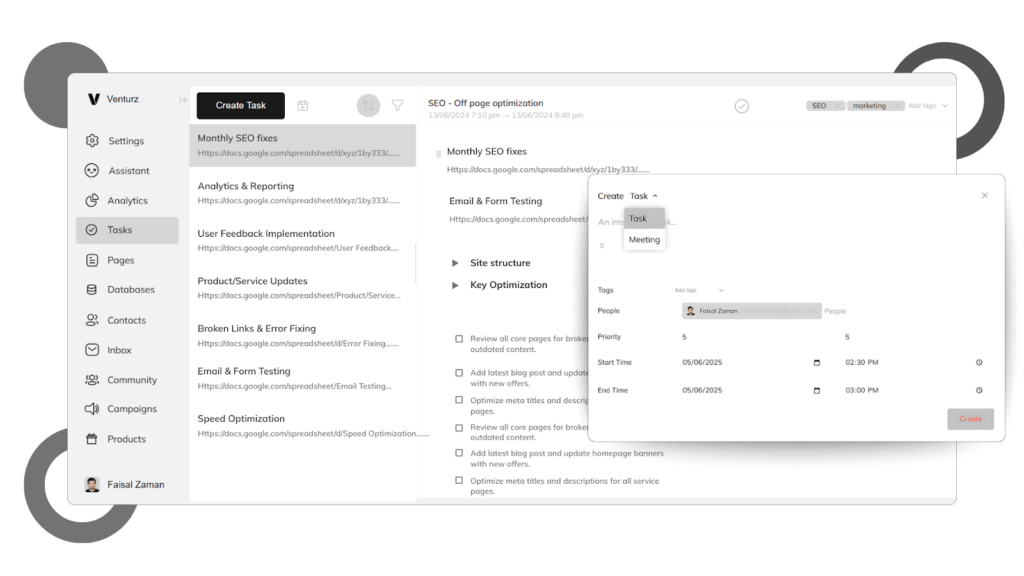
Venturz is an all-in-one business startup platform that includes project management alongside tools for CRM, marketing, communication, and finance. Ideal for startups and growing teams, Venturz offers a centralized workspace where users can manage tasks, collaborate in real time, and oversee business operations without switching platforms. Its intuitive design and built-in integrations make it a versatile tool for both project execution and strategic planning.
Features
- Manage projects with boards, timelines, and task lists
- Collaborate in real time with integrated chat and video calls
- Customize task workflows to match team processes
- Assign team roles, set priorities, and track progress
- Built-in CRM, email marketing, and finance tools
- Document sharing, commenting, and version history
- Insights dashboard for tracking project and business performance
Is Venturz right for you?
Venturz is a solid choice for startups and small-to-midsize teams that want a single tool for managing projects and broader business functions. While it may be more feature-rich than needed for very simple task management, its integrated platform is ideal for teams that value seamless collaboration and cross-functional workflows.
Pricing
Venturz offers a free plan with access to core project management features and unlimited users. Paid plans, starting from $29 per user/mo, unlock advanced capabilities like automation, analytics, and external integrations.
Reviews
You can view reviews of Venturz on its homepage.
Kanban Tool
From $6 per user/mo (Free plan available)
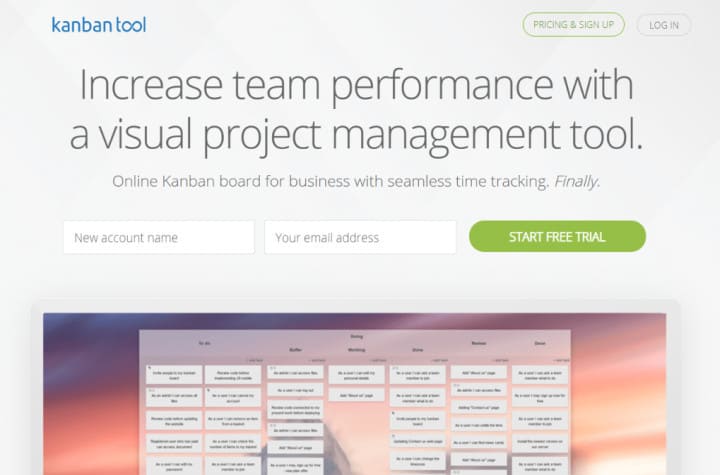
Kanban Tool is a lightweight project management system, designed specifically for teams that use the Kanban methodology. Armed with an AI-assistant, time tracking, reporting, and team analytics, it blends simplicity and productivity to speed up delivery.
Features
- Manage all of your tasks with Kanban boards
- Monitor progress and cumulative flow with dashboard reports
- Use the AI-assistant to instantly build tasks and checklists
- Track time spent on tasks
- Reports on team productivity, cumulative flow, and cycle time
Is Kanban Tool right for you?
If you’re already managing simple projects using Kanban, this is the perfect tool for you. But if you need more than just boards or your team is growing, other tools may be more suitable.
Pricing
The free plan comes with two boards and two users. Paid plans start at $6 per user/mo, growing to unlimited users, file storage, and time tracking as you progress further up the tiers.
Reviews
- “Kanban Tool has all the features of a kanban, while keeping it simple. It is not bloated with screens and buttons that make it hard to find what we want.” – Daniel, Engineering Researcher
- “No integrations – it would be a plus to push tasks to Kanban Tool e.g., from MS To-Do list.” – Charles, Operations Manager
ProWorkflow
From $18 per user/mo
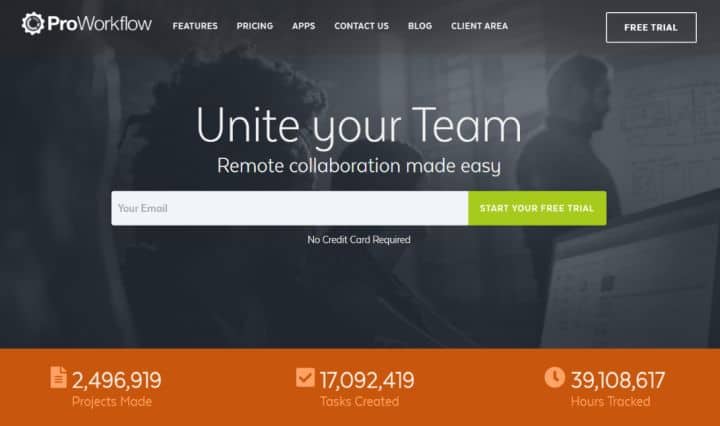
ProWorkflow is all about making collaboration easy, especially, for remote teams. It comes with tasks, timelines, and timesheet management. In addition, ProWorkflow also integrates with many finance systems to manage projects, generate invoices, and manage client relationships.
Features
- Timelines, Gantt charts, and Kanban boards give a holistic end-to-end view
- Keep track of progress with task management
- Use workload/resource management keeps the teams ticking over
- Track expense and materials by client or project
- Communicate with your team, clients, and contractors in one central space
Is ProWorkflow right for you?
If you want project management functionality with a focus on time, cost, and resource tracking, ProWorkflow is a great choice. For a better UI/UX at a lower cost, you may have to look elsewhere.
Pricing
ProWorkflow does not offer a free plan. Paid plans start at $18 per user/mo rising to $27 per user/mo for advanced customization and storage options. There’s also a quote-only enterprise package for dedicated support and advanced SLAs.
Reviews
- “Over the course of 10+ years, I’ve managed thousands of projects, varying in scope and complexity. And in that time, I’ve tried several different project management softwares. ProWorkflow is hands-down the best. It’s incredibly easy to use, packed full of features, and priced right.” – Steve, Co-Founder.
- “There are functions of the software that do not have much intuition, the tools to use to finish a job are not always at first sight, and forces you to find the place of the tool, which makes you lose valuable time.” – Verified User, Engineering.
Workfront (Adobe)
Contact for pricing details
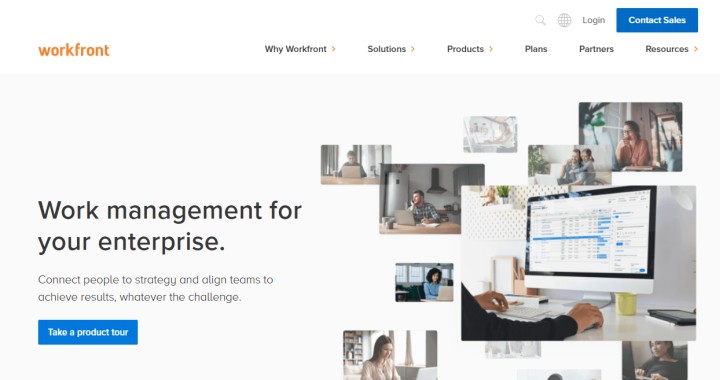
Tailored for marketing and creative project teams, Workfront gives you the tools to plan, deliver, review, approve, and track projects. It comes with features such as timelines, task management, and resource utilization features, and a number of out-the-box integration options.
Features
- Project and program visibility with a timeline
- Keep track of the deliverables through task management
- Prioritize projects with strategy management functionality
- Collaborate and approve creative designs through to sign-off
- Configurable dashboards bring key project metrics to life
Is Workfront right for you?
If you’re planning marketing or creative projects, or you already use the Adobe suite, Workfront is a great choice. Given Workfront is part of the broader ‘Adobe for Business’ platform, it’s unlikely to be a viable option in isolation.
Pricing
Pricing is available upon request, with three tiers to choose from: Select, Prime, and Ultimate.
Reviews
- “What I like most about Workfront is how practical and complete it is for project management. Its structure makes it easy to organize tasks, assign responsibilities, and track progress, which improves teamwork and optimizes delivery times.” – Armando, Business Analysis
- “Workfront is great for EITHER project management OR project finance tracking. When you try to make it do both, it really struggles. If you take steps to make the finances accurate, you mess up the project plan structure.” – Ricky, Program Manager
Podio
From $11.20 per user/mo (Free plan available)
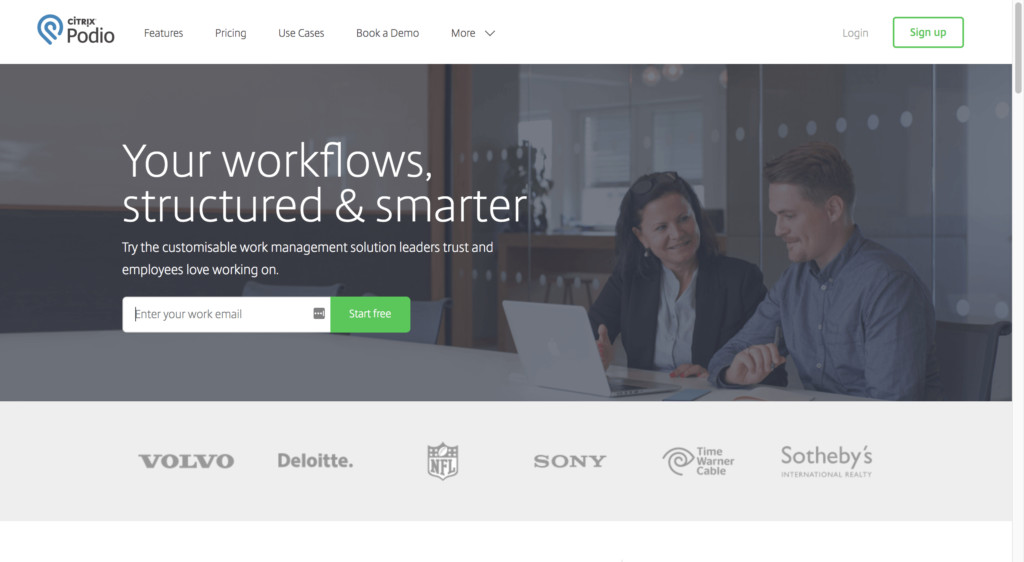
Podio offers an all-in-one platform for managing your project workflow. Project management is delivered via integrated task management and board functionality with beautiful reports configurable on the dashboard. You can also deliver on the go with the Podio app.
Features
- Integrated task management to keep track of deliverables
- See overall team progress with Boards
- Create beautiful dashboard reports and share them with your team
- Stay in sync with social collaboration and messaging
Is Podio right for you?
If you’re a fan of other Citrix products or need to integrate with their other products, Podio is an easy choice. However, those with enterprise-level project management needs may find the functionality limited.
Pricing
Podio offers a free plan for up to five users. Paid plans start at $11.20 per user/mo rising to £19.20 per user/mo for the most premium features.
Reviews
- “Our company is using Podio for last 8 months for managing tasks and people in our project without even coding. We were able to customize automation according to our needs, and it is in our budget – best thing ever.” – Radhika, Digital Marketing
- “I can get a variety of tools and features, but it lacks basic functions like a time tracker. I find it slow sometimes. I think app performance needs improvement, especially for graphic-intensive work.” – Suryansh, Marketing Specialist
TeamGantt
From $39 per user/mo (Free plan available)
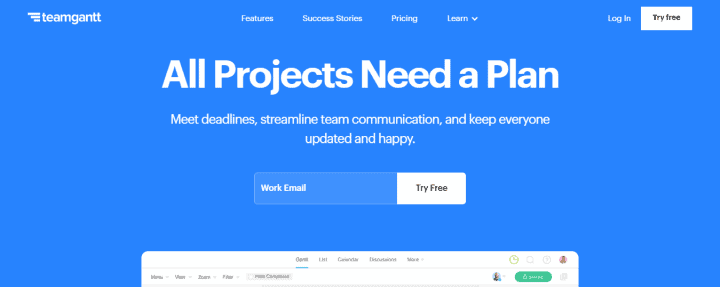
TeamGantt makes end-to-end project planning a breeze. As the name suggests, the tool is fully focused on the Gantt Chart format, with it easy and simple to see end-to-end project plans in one place. In addition, you also get task management, portfolio management, and project template features, with integrations to apps you already use.
Features
- Easily drag and drop your project plan with timelines
- Drill down into deliverables with task management
- Manage team capacity with resource management
- See the bigger picture with intuitive reporting dashboards
Is TeamGantt right for you?
If you’re planning long-term, dependent projects as part of a portfolio, TeamGantt is the perfect tool. However, it may be a bit too expensive for smaller teams.
Pricing
TeamGantt offers a free-forever plan for up to three people, one project, and 60 tasks. Paid plans start at $39 per user/mo, offering unlimited tasks and collaborators, and up to 20 projects per manager.
Reviews
- “TeamGantt gives me a compact, simple and very easy to use platform that offers significant functionality and tremendous collaborative applications for team management.” – Roy, Quality Assurance
- “I was searching for a solution that had a Gantt Chart in Trello so that I could keep everything in one place. But updates to the chart are slow to load, and you have to flip between two systems to make certain changes.” – Verified User, Construction
Planview AdaptiveWork
Contact for pricing details
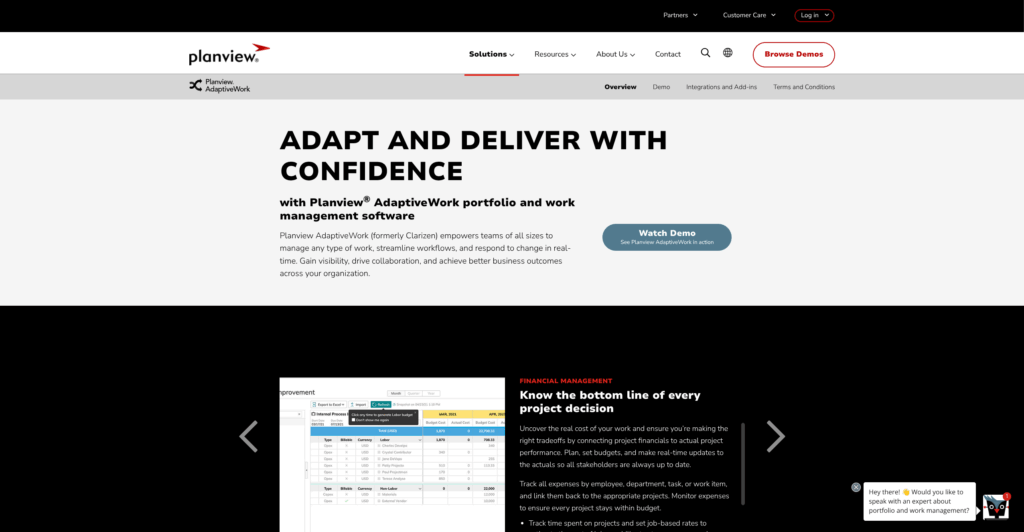
Planview AdaptiveWork (formally, Clarizen) empowers teams of all sizes to manage any type of work, streamline workflows, and respond to change in real-time. With a strong focus on demand and portfolio management, it helps large project departments get all of their information in one place to enable portfolio management, capacity planning, and reporting.
Features
- Create detailed project plans with tasks, milestones, and dependencies
- Oversee real-time resource management
- Configure workflows and alerts for key project activities, risk, and updates
- Detailed financial reporting for budget management at an enterprise level
Is AdaptiveWork right for you?
If you’re running complex, data-driven projects, or you’re monitoring a large project portfolio, AdaptiveWork is a good choice. For smaller teams or those that need more user-friendly task management, AdaptiveWork will feel overly complex.
Pricing
Pricing is available upon request across AdaptiveWork’s two tiers; Enterprise and Unlimited. There are also additional objects available on-demand to create a truly bespoke solution.
Reviews
- “Available with plenty of unique and rich features for creating and managing your projects. Keeping track on all your ongoing projects through this software. It can be used for multiple organizational tasks for creating and managing various project portfolios.” – Mukul, Web Developer
- “Almost nothing works well out of the box; many processes are completed outside of the tool and then entered into the tool. The support for the product is lacking; with Clarizen being bought by Plainview, there are different growing pains.” – Verified User, Law
ClickUp
From $7 per user/mo (Free plan available)
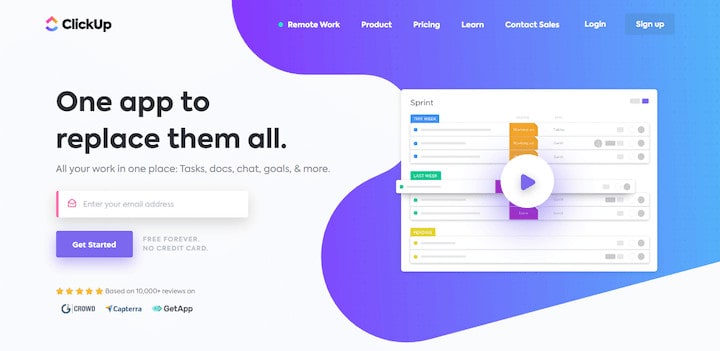
ClickUp’s promise is to provide “one app to replace them all.” So, unsurprisingly, it offers all the core project management features you’d expect, such as timeline planning, task management, and chat. Alongside this, it’s also packed with resource management, collaboration, and workflow features to enable teams of all shapes and sizes to work together.
Features
- Manage the bigger picture with timeline planning
- Integrated task management to keep the teams on track
- Plan your next wave with task boards
- Collaborate instantly with baked in Docs and team chat
- Integrate with household names such as Slack, Google, and MS Teams
Is ClickUp right for you?
If you’re looking for a range of features, ClickUp offers something for everyone within a sleek UI. On the other hand, those with more targeted requirements may find ClickUp too complex.
Pricing
The free plan comes with unlimited users and unlimited tasks. Paid plans start at $7 per user/mo adding in additional storage, collaboration features, and resource management.
Reviews
- “Our team loves ClickUp! Myself and one of our Account Managers in particular. Like any project management system, it takes some planning and set up (to ensure your team is using it the same way across the board) but, once you’ve got your core needs in place, it’s very easy to use and customize.” – Brittany, Technical Project Manager
- “Some of the functionality is a little bit hidden. A reply to an email is displayed as a tiny word under the recent email, which isn’t obvious. I could easily miss something important. The activity and detail panels were confusing at first, and I’d prefer to see all information up front, rather than toggling between two tabs.” – Verified User, Marketing
ActiveCollab
From $8.00 per user/mo
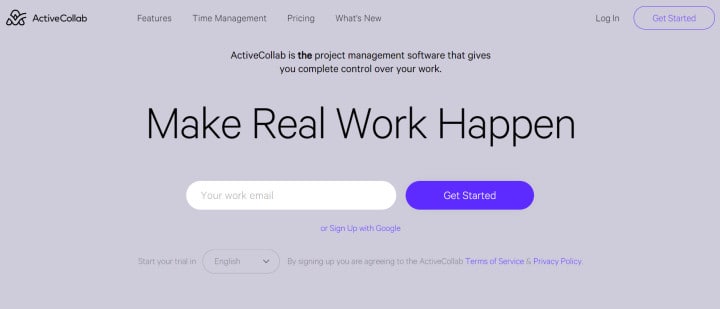
ActivCollab is the perfect tool for agencies and consultancies that need to get their teams together in one place to produce great work. It blends project management features with invoicing, communication, estimates, and workload management to help billable teams optimize their work across clients.
Features
- Map out the project with timeline planning
- Task management keeps each deliverable on schedule
- Workload management tracking ensures no team is ever overworked
- Invite and collaborate with unlimited clients directly in ActiveCollab
- Invoice clients for work completed and track expenses as projects progress
Is ActiveCollab right for you?
If you need a project management tool that focuses on getting work done in an agency environment, ActiveCollab could be for you. But those with enterprise-level needs, or those in different sectors, needs may find the tool limiting.
Pricing
ActiveCollab does not offer a free plan. However, the paid plans start at $8 per user/mo for most teams. If you’re a business of 100+, pricing drops to as little as $3 per user/mo on a custom arrangement.
Reviews
- “ActiveCollab is a platform specifically designed for the planning, execution, and monitoring of all types of projects that require a workflow that produces visibility for all team members, in addition to managing information related to budgets, execution times, deadlines in which each task must be accomplished, and much more.” – Jose, Project Manager
- “Tasks can be assigned to only one person (though you can add watchers/subscribers). There’s a lot of manual processes that make this system way more cumbersome than project management should be.” – Verified User, Marketing
Redmine
Free self-hosted version
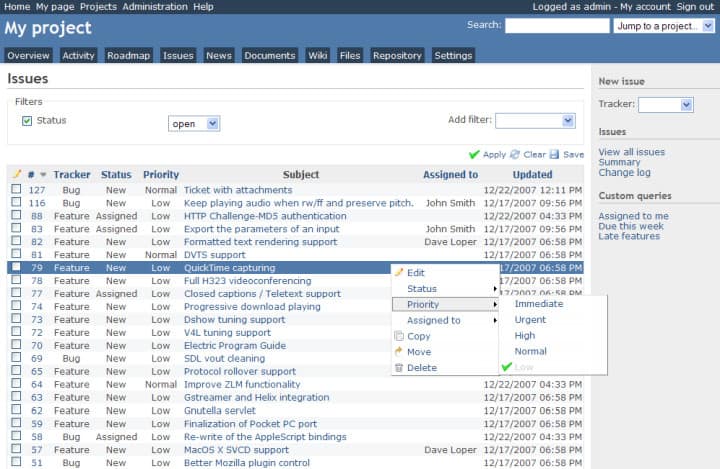
Redmine is different from other tools on this list. This open-source tool offers timeline management, issue management, and task management features. However, as you’d expect from a community-based offering, Redmine has an outdated user interface.
Features
- Manage timelines with Gantt charts
- Keep track of the team’s progress with task management
- Create a single source for document and file management
- Integration with source code management tools such as GIT and SVN
Is Redmine right for you?
If you’re comfortable with installing and maintaining open-source tools, Redmine is definitely worth a look. However, it has a dated UI, which most teams may not enjoy.
Pricing
As an open-source tool, Redmine is committed to being free forever to its community of members and contributors.
Reviews
- “Redmine tool is used for bug , incident or to track particular task in your project. It is really user friendly and we can manage our multiple issues and track bugs, system defects in this tool.” – Poola, Technical Analyst
- “Out-of-the-box Redmine’s user interface can seem very bland and the learning curve to configure the software can be quite steep, so some learning and adaptation is required before you can start using the software.” – Marco, Product Lead
Paymo
From $5.90 per user/mo (Free plan available)
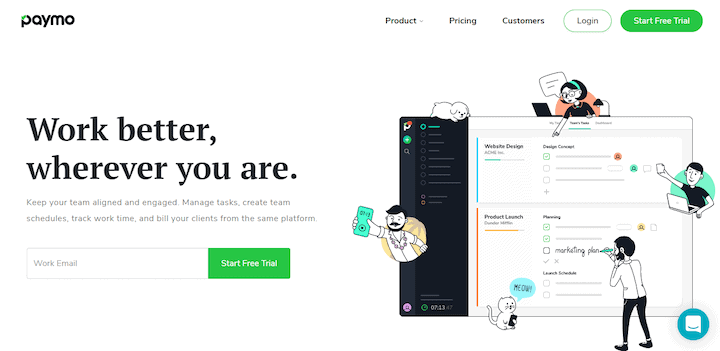
Paymo offers an affordable project management software to manage client work, track time, send invoices, and measure profitability. Aimed at small businesses, it offers a lightweight, visual-led project management capability that helps teams run projects from first client engagement through to invoicing.
Features
- Plan ahead using Paymo’s project timelines
- Task management features keeps the team ticking over
- Keep everyone at optimum capacity with workload management
- Track time on tasks with in-build time tracking
- Bill clients directly from the platform with integrated invoicing
- Unlimited storage place means you can keep all work in one place
Is Paymo right for you?
If you need a well-rounded tool for tracking, delivering, and billing projects, Paymo is a great choice. But if you need more advanced project management, you may find Paymo lacking in depth once you scratch the surface.
Pricing
Paymo has a free plan for unlimited users that’s limited to five clients and ten projects. Paid plans start at $5.90 per user/mo, layering in project templates, time tracking, guest access, and Gantt charts.
Reviews
- “I like the way Paymo has been designed. With its straightforward menu sidebar, it’s easy to access everything your business needs quickly and easily. From adding users or managing subscriptions at the click of a button, to creating tasks in the ‘Project’ tab.” – Jamie Lee, Sales Manager
- “It’s simple, intuitive to use, I can imagine it will suit a small team really well. But lacks several key features, compared with its alternatives, and it is not customizable at all.” – Verified User, Consulting
Epicflow
From $22.50 per user/mo
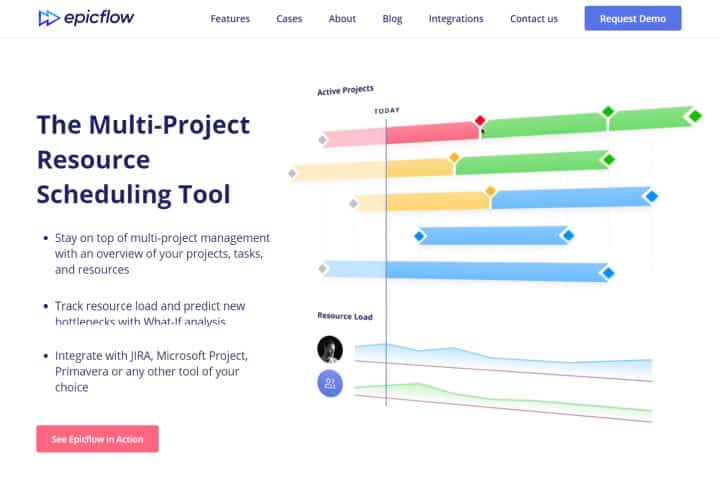
If you need data-driven project management at scale, then Epicflow might just be the tool for you. It combines timelines, task management, and boards. Plus, it comes with reports to identify bottlenecks in your project schedule.
Features
- Monitor overall progress with project timelines
- Keep actions on track with task management
- Task boards give a visual view of any blockers
- Resource & competency planning ensures you have the right people on the right projects
- Leverage AI-powered data to identify bottlenecks and predict “what-if” scenarios
Is Epicflow right for you?
If you’re looking to drive projects through data insights, Epicflow will allow you to harness the power of your data. However, those looking for simplicity, or those on a tight budget, may find Epicflow is more than they need.
Pricing
Epicflow doesn’t have a free plan. Pricing starts at $22.50 per user/mo, with an Enterprise package for those running more than 50 projects.
Reviews
- “I’m a project manager at an outsourcing company, and I’ve been a confident Epicflow user for more than five years. The tool helps me easily resolve most project management challenges and simplifies my daily routine.” – Ekaterina, Project Manager
- “To get the real value, Epicflow requires my project information to start working, like tasks and their dependency network, a rough estimate of each task, a resource group assigned to complete the milestone, and project and milestone deadlines. The input data must be compatible with the Epicflow system.” – Andrey, Project Manager
Orangescrum
From $7.99 per user/mo (Free plan available)
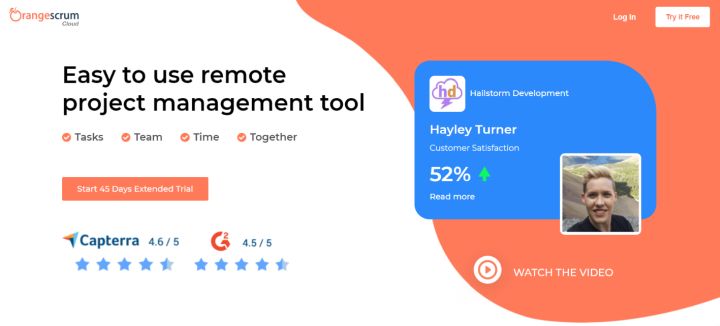
Orangescrum is a simple and clean Agile project management app. It comes with task management, resource management, project budgeting, and bug tracking features, with dedicated features for those working in a Scrum-based framework.
Features
- Plan iterations ahead with timeline views
- Manage the details of the current sprint with task management
- Boards optimize and track project flow
- Keep team member’s capacity consistent with resource management
- Collaborate inside Orangescrum with chat and document sharing
- Time tracking and smart reporting measure team productivity
Is Orangescrum right for you?
If you’re operating in an agile software environment, Orangescrum has some tailor-made features for your projects. On the other hand, if you’re delivering waterfall projects at scale, Orangescrum might not meet your needs.
Pricing
Orangescrum ‘Work’ and ‘Agile’ both have a free plan for one user. After that, the Premium plan is $7.99 per user/mo for a minimum of five users.
Reviews
- “Very easy to setup and use. Configuration is very simple and ready to use. Small in size and takes less time to install. Has provision to add snapshots and custom templates. It supports Scrum and Kanban methods.” – Anish, Role Unknown
- “Speed can be improved further. Interface can be made more attractive.” – Anirban, Small-Business CEO
Tempo (Formally LiquidPlanner)
From $15 per user/mo
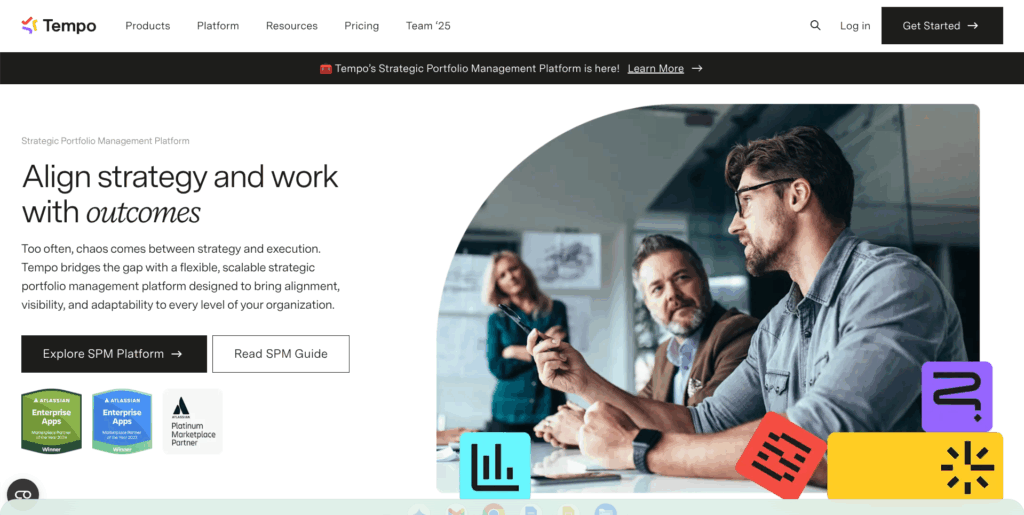
Formally LiquidPlanner, Tempo provides a flexible, scalable strategic portfolio management platform designed to bring alignment, visibility, and adaptability to every level of your organization. It’s less focused on day-to-day task management and instead, aims to give a portfolio-level view on all of your projects to aid capacity planning, risk management, and strategic alignment.
Features
- Integrate with other project management tools to create a strategic view
- Use predictive scheduling to forecast capacity and resource demand
- Build roadmaps that align with strategic objectives.
Is Tempo right for you?
If you’re looking for a portfolio management tool to bring your other project information together in one place, Tempo could be a good choice. But if you need traditional task-based project management, Tempo will be too high-level.
Pricing
There’s no free plan for Tempo. Paid plans start at $15 per user/mo, rising to $42 per user/mo for the most powerful enterprise portfolio management features.
Reviews
- “The price of the program might be high. Although Tempo includes a few different pricing alternatives, the most used ones are incredibly expensive. For startups and smaller companies, this could be a barrier.” – Satyam, Small Business Owner
- “The user interface is nice, clean and user-friendly, which makes it easy for teams to begin with making and handling roadmaps. This feature is especially useful for customers with different levels of technical knowledge” – Ruby, Marketing Manager
ProofHub
From $45 per month flat fee
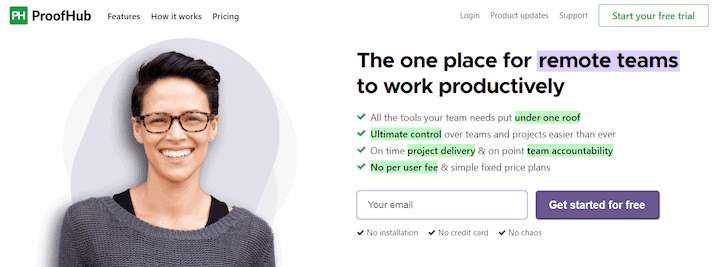
ProofHub provides a clean collaborative environment to help teams get their work done faster. Bringing together Gantt timelines, task management, document collaboration, and much more, ProofHub claims to put everything you need in one place!
Features
- Create Gantt chart timelines for project overviews
- Manage individual tasks to keep the team moving
- Collaborate on documents and approve changes
- Time tracking for accurate bill project time
Is ProofHub right for you?
If you need a central tool for collaborating on project work, ProofHub should definitely be on your list. Plus, it also comes with proofing features for creative projects. However, it doesn’t have a free plan.
Pricing
ProofHub doesn’t offer a free plan. Paid plans start at $45 per month for unlimited users running 40 projects. For unlimited projects, the price rises to $89 per month flat fee.
Reviews
- “I use ProofHub because it keeps things simple and easy for me. It brings all I need to manage the work of my remote team in one place: projects, documents, team communication, and tools.I can easily create projects, add tasks, and assign tasks to team members.” – Ashok, Administration
- “Some of the user interface isn’t as intuitive as expected or desired. The email notifications also seems to be spotty at times.” – Verified User, Marketing
Celoxis
From $25 per user/mo
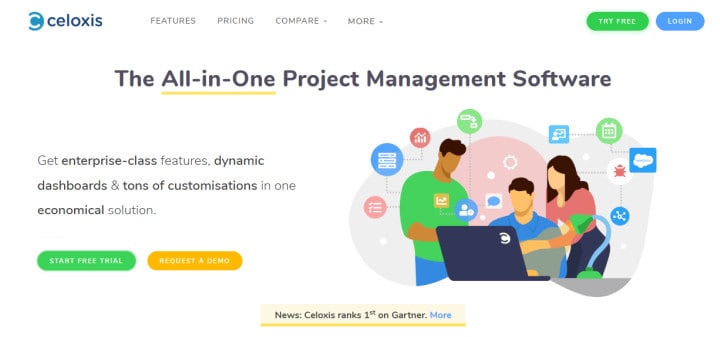
Celoxis should definitely be on your list if you’re managing enterprise projects with a strong lean towards data and analytics. Alongside timeline, task, and board management, Celoxis combines features to monitor risk, issues, and resource management. You can also customize dashboards and integrate with your favorite tools, such as Slack.
Features
- Manage project timelines for a complete overview
- Keeps deliverables on track with task and board management
- Manage project risks and issues all from one place
- Customize fields, objects, and workflows to suit your processes
- AI-driven insights to plan projects, spot risks, and make decisions
Is Celoxis right for you?
If you’re delivering in the enterprise space, Celoxis is a great option to support larger project teams that need detailed insights. However, for simpler needs, you may favor a lighter, cheaper tool.
Pricing
There is no free plan with Celoxis, but paid plans start at $25 per user/mo. For additional features such as client access, portfolio management, and APIs, prices rise to $35-$45 per user/mo.
Reviews
- “Since I started using Celoxis, plannning, tracking and managing tasks has become easy. My projects stay organized and on track, and I can handle more projects faster and with precision. Its Gantt chart helps with graphical representation of my tasks progress and cost, which has really made my work easier.” – Oscar, Developer
- “Cluttered Interface can be improved as it is something which often confuses new users and also makes it hard for new users to navigate, thus increasing the learning curve” – Akshay, Software Developer
ProjectManager
From $14 per user/mo
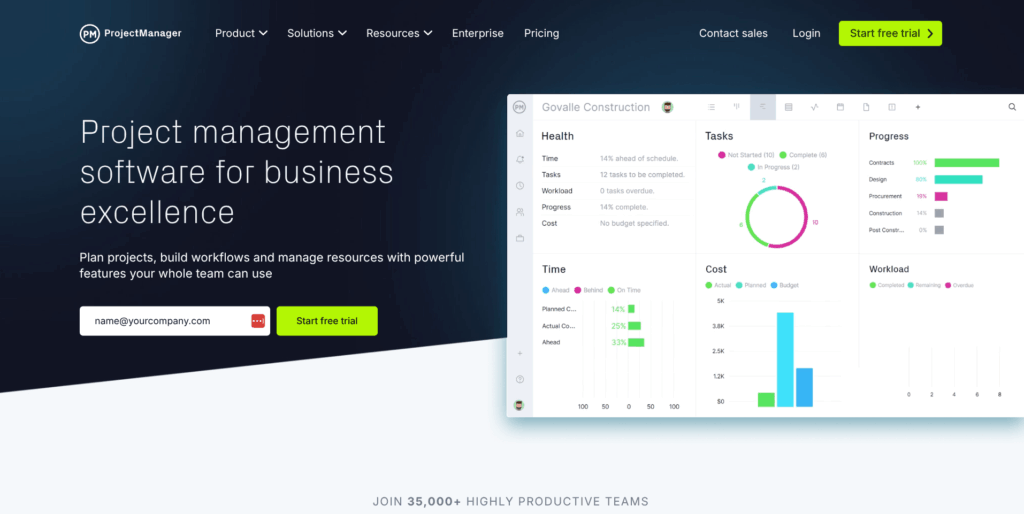
As a central hub to manage tasks, timelines, and reports, ProjectManager puts everything project teams need in one place. With integrations into tools such as OneDrive and Salesforce, it’s no wonder ProjectManager is trusted by big enterprises worldwide such as NASA, McDonald’s, and Siemens.
Features
- Plan end-to-end with Gantt timelines
- Keep track of tasks with project kanban boards, Gantt charts, and lists
- Create intuitive reports directly from the dashboard
- Bring projects together into enterprise-level portfolios
- Integrate with tools such as Office, Slack, and many more
Is ProjectManager right for you?
ProjectManager hits the sweet spot for projects big and small although those on a limited budget might want to consider a tool that offers a free option.
Pricing
ProjectManager doesn’t offer a free plan, but the paid plans start at $14 per user/mo with Team, Business, and Enterprise plans available.
Reviews
- “The user interface is simple to use and easy to communicate to others. It has a great team environment to get adherance to the usual project management activities. It has a dashboard and report that can be easily used so can be powerful for managing projects.” – Adam, Small Business Owner
- “The app works very well on a computer, but using it on a mobile device is not as comfortable.” – Jay, Project Manager
Kantata
Quotes are available upon request
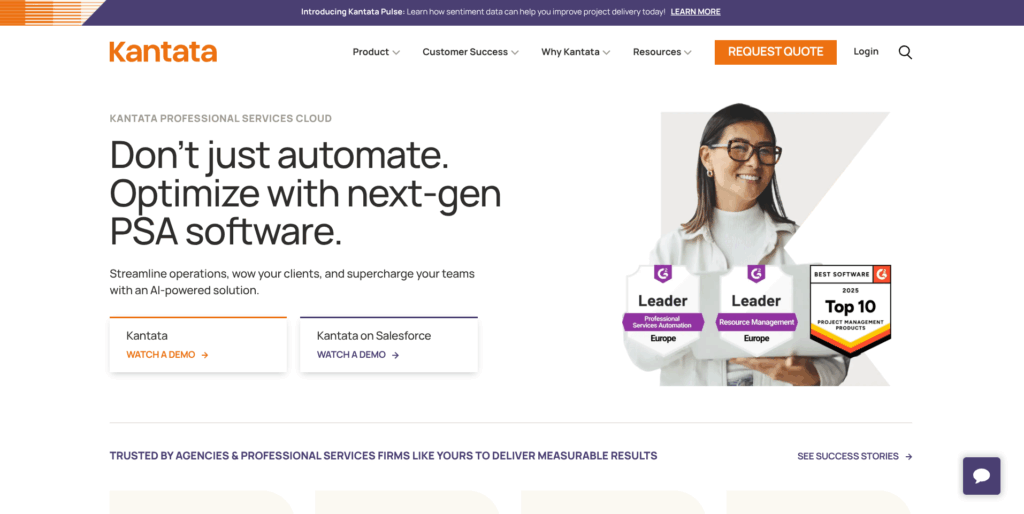
Kantata (formally Mavenlink) is a full-service productivity tool with a focus on resource, financial, and project management. For projects specifically, it offers all the features you’d expect to create and manage tasks, with an enhanced focus on reporting and portfolio management.
Features
- Keep track of the big picture with timelines
- Task and board management keep action logs up-to-date
- Ensure team capacity is optimized with resource management
- Get a holistic view of your portfolios, with detail risk and resource analysis
- Automatically generate and schedule beautiful reports
Is Kantata right for you?
Kantata is a great tool for enterprise looking for a holistic view of projects, portfolios, finances, and risks. But given its enterprise focus, it’s unlikely to fit or be cost-effective for smaller teams.
Pricing
Pricing is available upon request based on your company/team size.
Reviews
- “Kantana is simple, useful and efficient. Other project management applications are bloated with a multitude of features that encroach on the UI and ultimately slow you down as you navigate around them trying to find the features you actually want to use.” – Kenny, Staff Consultant
- “What I dislike about the Kantata is the lack of enough two-way system integrations with QB Online and other systems. This creates several manual processes in our company and increases the cause of human error to financial manage project budgets with our clients.” – Vincent, COO
Zenkit
From $8 per user/mo (Free plan available)
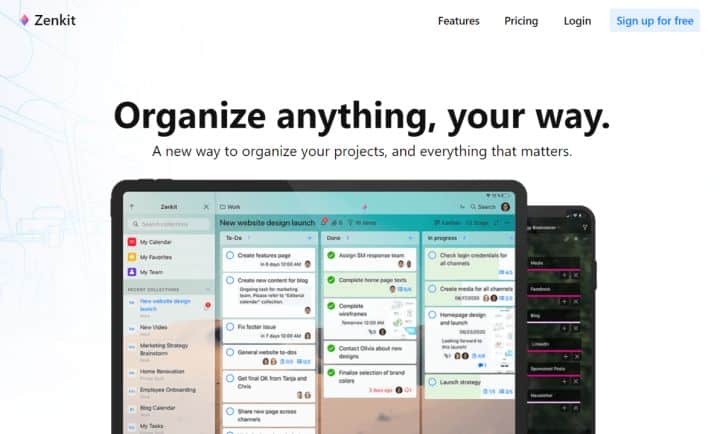
In recent years, Zenkit has evolved to become a great full-service project and work management solution. Whether through Kanban boards, Gantt charts, or mindmaps, it offers several ways for teams to track, manage, and collaborate on project tasks without the bloat of more complex tools.
Features
- Plan and monitor tasks with Zenkit’s boards
- See the bigger picture with Gantt timelines
- Create a team wiki to keep information stored centrally
- Collaborate on new ideas and designs using built-in mindmaps
- Two-factor authentication secures data
Is Zenkit right for you?
If you’re looking for flexibility in how you collaborate, Zenkit is lightweight and easy to get started with. But bigger teams might find the tool limiting.
Pricing
The free plan (Personal) is great for individuals and small teams. Paid plans start at $8 per user/mo unlocking features such as Gantt charts, custom fields, and SSO.
Reviews
- “For solo projects and task management (I haven’t evaluated it for group productivity), Zenkit is best-in-class. It has a formidable array of features that are not found in any other SMB app.” – Brookes, Consultant
- “Zenkit’s data storage limits are relatively low. And the mindmap representation is a bit different from what one’s used to finding in mind mapping-related software, but this seems to be mostly due to web components limitations.” – Suraj, Senior Engineer
nTask
From $3 per user/mo
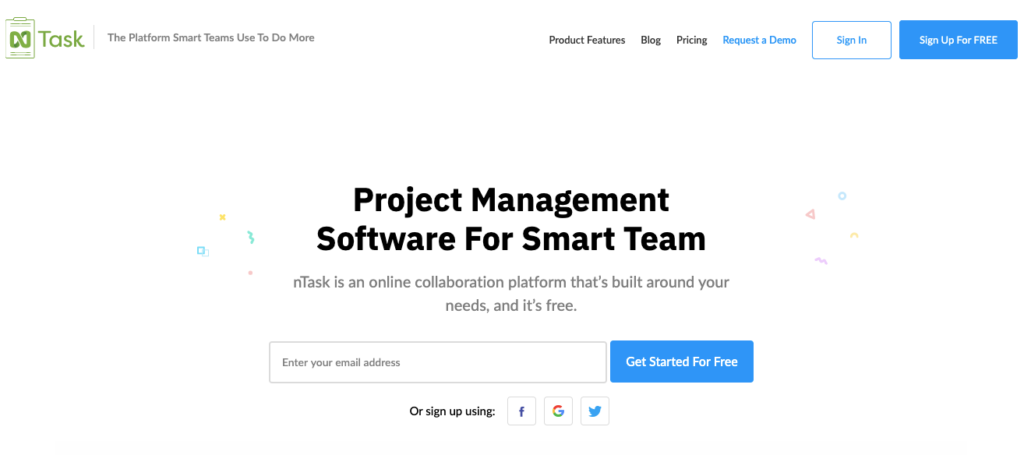
If simple and clean collaboration is what you need, nTask is a great tool to consider. Combining a range of features for managing timelines, task management, team organization, and nTask has most of the project management boxes ticked at a very inviting price point.
Features
- Track tasks with timelines, boards, and calendars
- Risk and issue management for enterprise-level projects
- Smart search and filtering to find what you need
- Keep sight of budgets with time and resource tracking
Is nTask right for you?
nTask is a simple, budget-friendly project management tool that’s great for teams looking to boost their productivity. If you need large-scale portfolio management, nTask might not be enough.
Pricing
There is no free plan, but paid plans start at just $3 per user/mo. If you want to add unlimited projects or integrations, opt for the $8 per user/mo ‘Business’ plan.
Reviews
- “nTask fits perfectly for medium-sized and enterprise companies which are fond of teamwork. This communicating tool stands out with its agile methodologies. It helps in managing the data and organizing the tasks to be done at a specific time.” – Oberon, Director Talent Acquisition
- “The interface is not very intuitive and i found myself preferring other solutions or excel to this one as its not as easy to preview the information.” – Diego, COO
ZenTao
From $39.90 per year (free, open source version available)
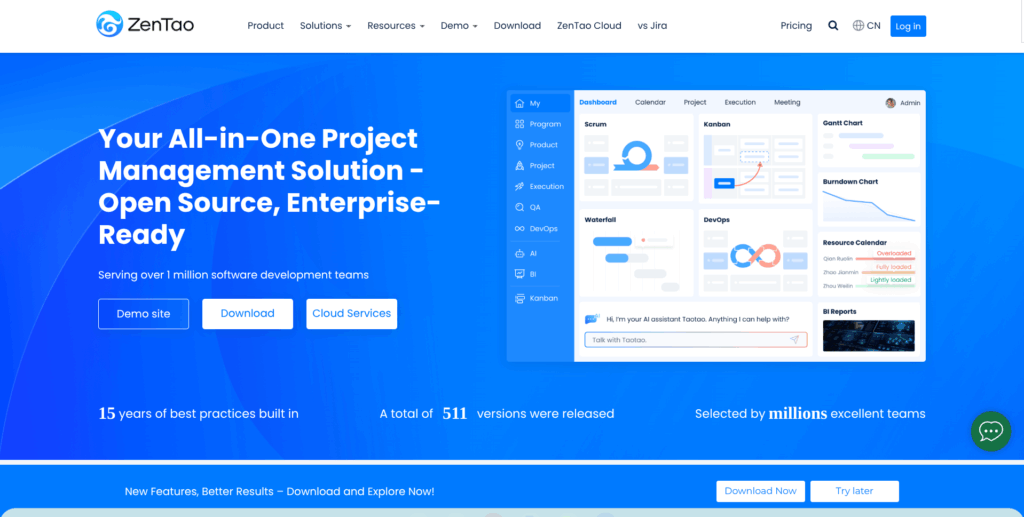
ZenTao is the perfect tool for delivering projects and products at scale using Scrum. It utilizes task and board management to keep track of your sprints, with a strong lean towards Agile software teams that also manage releases and bug-fix management. As an open-source product, there’s a huge community presence and numerous resources to support onboarding.
Features
- Keep track of sprint deliverables with board and task management
- CI management and integration with tools such as GIT & Jenkins
- Customizable and exportable reports
- Resource management functionality including holiday/sickness tracking
Is ZenTao right for you?
If you’re delivering purely using Scrum, ZenTao is tailor-made to speed up the process. On the other hand, it’s not very useful for non-software project teams.
Pricing
There is a limited open-source solution from ZenTao which is free forever if you self-host. More powerful, Cloud-based plans start at $39.90 per user, per year.
Reviews
- “Zentao is the best Project management tool. Currently i’m using the community edition for my professional work, which is free and open source tool for daily work. Its best feature is time tracking for my international project and side by side document management.” – Tanushree, Cyber Security Analyst
- “Some of the additional features are not so intuitive or easy to find. Some members of our team are not as receptive to how great of a tool this is because they haven’t unlocked its true potential.” – Florin, iOS Developer
Targetprocess
Pricing details available on request
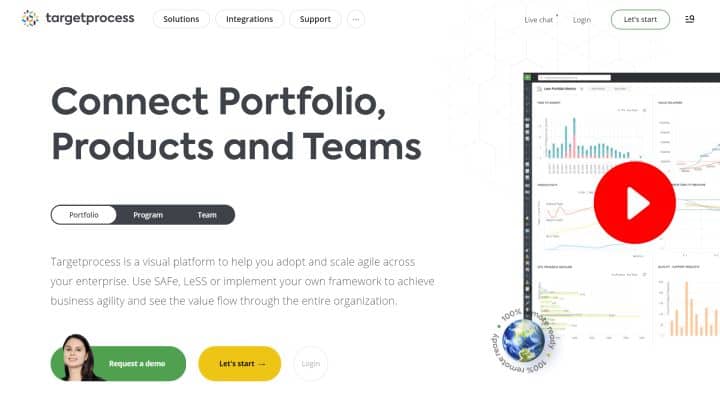
Part of IBM’s Apptio suite, TargetProcess supports the adoption and delivery of Agile methodologies across teams. It comes with flexible task, timeline, and board management features for project managers, which also rolling this information up to product, portfolio, and leadership level to support wider business stakeholders.
Features
- Timeline planning delivers a high-level project/program view
- Task and board management keep teams on track
- Pre-built configurations match any delivery framework
- Report on progress at project, program, and portfolio level
- Integrate with tools such as BitBucket, Jira, and Rally
Is Targetprocess right for you?
If you’re delivering agile at scale, Targetprocess supports your team’s end-to-end journey. But it might be overkill for small teams or those not in software development.
Pricing
Pricing for Targetprocess is only available on request, with a bespoke solution created based on your business requirements.
Reviews
- “It is a comprehensive issue and project tracking platform that includes many features aimed at small to mid-sized companies who are employing SAFe methodologies for their Product/Project delivery process.” – John, Director of Product Management
- “The platform’s flexibility, while powerful, can also make it complex and difficult to set up initially, especially for teams unfamiliar with Agile frameworks or extensive customization.” – Cody, Senior TBMA
OpenProject
From $7.25 per user/mo with a minimum of 25 users (Free self-hosted version)
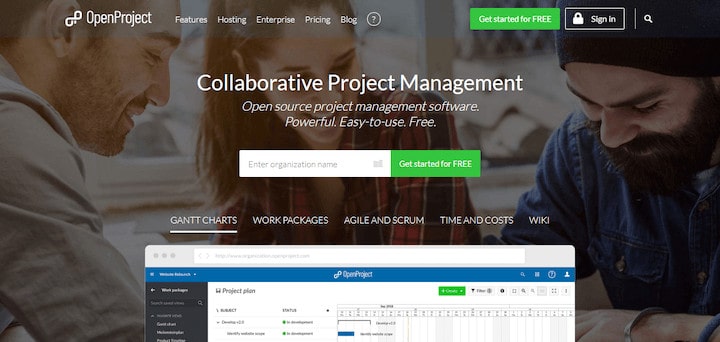
If you’re looking for an open-source product with an edge, OpenProject is definitely worth a look. By combining tasks, timeline, and board management, OpenProject creates an environment perfect for collaboration. In addition, it also has features for time tracking and bug management. Plus, there’s a mobile app to keep you delivering on the go.
Features
- Timelines give a holistic overview of project performance
- Tasks and boards keeps teams on top of the detail
- Dedicated cost, time, and budget management features
- Configurable Wiki for documenting and sharing processes
Is OpenProject right for you?
If you want a completely free, enterprise-grade project management tool, OpenProject is a good choice. On the minus side, you’ll have to manage the installation and maintenance on your own. However, if you’re on a bigger budget, with a team of at least 25, a hosted version of OpenProject is available too.
Pricing
As an open-source product, OpenProject’s Community Edition is free forever. On the other hand, paid hosted plans start at $7.25 per user/mo with a 25-user minimum entry.
Reviews
- “OpenProject is an all-in-one tool with wide project management capabilities. The tool even allows to manage tasks, timeline and track issues. Additionally, the team members can customize the workflow, set up detailed project roadmap using its intuitive interface.” – Charmy, Product Lead
- “Very rigid, its design does not facilitate adoption and does not necessarily lend itself to use in an agile environment. Long and complex skill development for all users.” – Julien, Product Owner
Redbooth
From $9 per user/mo
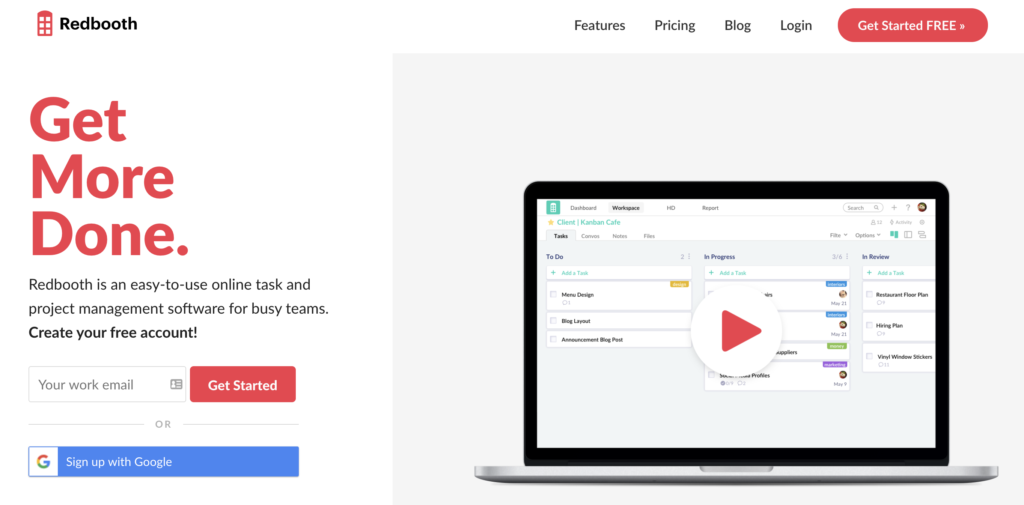
Redbooth enables teams to communicate and improve their task management so they can deliver great projects. Project activity is tracked across tasks, boards, and timelines, with dashboards to prioritize work, get fast insight into progress, and dive into team productivity.
Features
- Keep teams on track through timelines, boards, and tasks
- Speed up task allocation with Redbooth’s ‘Predict’ engine
- Built-in file sharing and conversations to boost collaboration
- Understand team workload with productivity reports
- Integrate Zoom video calling directly within Redbooth
Is Redbooth right for you?
If you’re looking for a simple tool to manage simple projects while collaborating with the team, you’ll love Redbooth. If you’re managing larger projects, its narrow functionality may put you off.
Pricing
Redbooth doesn’t offer a free plan. Paid plans start at $9 per user/mo and include unlimited workspaces, time tracking, and HD video meetings.
Reviews
- “Task management is easy. I can easily assign tasks to my team. I can the work progress as everyone who finishes leaves their comments. All the projects files are uploaded to Redbooth, and it serves as a backup as well.” – Anita, HR Recruiter
- “For development and complex projects it can be somehow limited. Integrations with third party apps somehow limited. Seems that development and improvement of the app is quite limited or slow.” – Verified User, Automotive
MeisterTask
From $10 per user/mo (Free plan available)
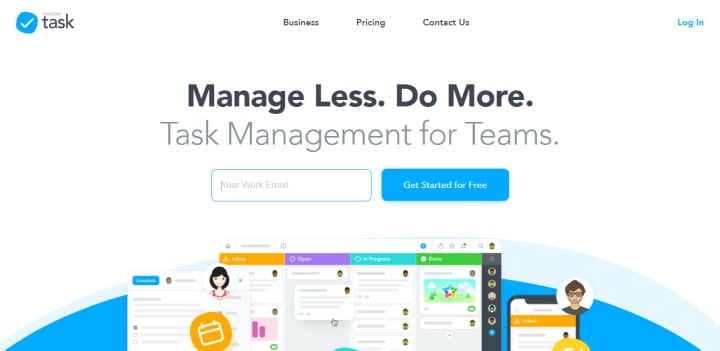
MeisterTask is a work management, task management, and documentation tool that makes it easy for teams to come together and collaborate fast. It’s simple and easy to use, with built-in AI and project templates designed to take the legwork out of project admin.
Features
- Track task progress using Kanban boards and timelines.
- Create custom workflows and automate repeating workflow tasks.
- Add custom fields and file attachments to tasks.
- Accurately track billable hours with time tracking.
- Get a detailed overview of a project with reports and dashboards.
Is MeisterTask right for you?
MeisterTask is a budget-friendly and easy-to-use task management tool. If you’re strapped for funds, it may be the right tool for you. On the other hand, if you’re after complex features, it might feel limited.
Pricing
MeisterTask’s free plan is for individuals managing up to 3 projects. Paid plans are $10 or $20 per user/mo, adding in additional features such as AI prompts, integrations, and custom reporting.
Reviews
- “I’ve been using MeisterTask for a few months now, and I have to say, it’s a game-changer! The ease of use is phenomenal – everything is intuitive and straightforward. Implementing it was a breeze, and the onboarding process was super smooth.” – Amir, Growth Marketer
- “The notification system that MeisterTask offers me for my mobile device is a bit slow to send notifications at the right time. On several occasions, I have viewed too late when new tasks have been placed for me or for my workgroup.” – Marilla, Sales Manager
Todoist
From $4 per user/mo (Free plan available)
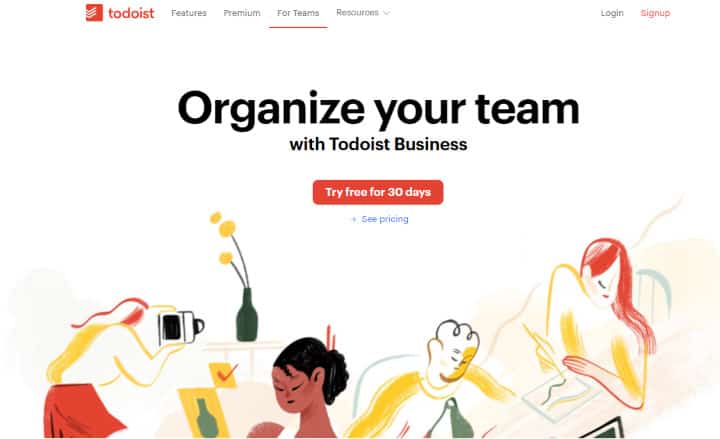
Todoist is a very simple task management tool that helps small teams combine their work into projects for quick and simple collaboration. Unlike many other project management tools, Todolist focuses on simple task management, which makes the UI easy to pick up in minutes.
Features
- Capture, prioritize, and track tasks and sub-tasks
- Get notified when people post comments or update tasks
- Collaborate on tasks using comments
- Get daily progress with color-coded charts
Is Todoist right for you?
If you’re looking for a full project management tool, Todoist might disappoint you. However, it’s a fantastic day-to-day checklist to get things done with your team.
Pricing
All plans in Todoist come with project and people limits. The free plan is limited to 80 projects for up to five people in each project. Paid plans start at $4 per user/mo.
Reviews
- “It is a simple and quick task software. It is very simple to add tasks. The learning curve is also very easy compared to other task softwares. I use it everyday, I can put something in it and have it remind me or show up in my task list days later.” – Soleiman, Business Owner
- “Not mature for complete project management.” – Verified User, Computer Software
Taskworld
From $11 per user/mo
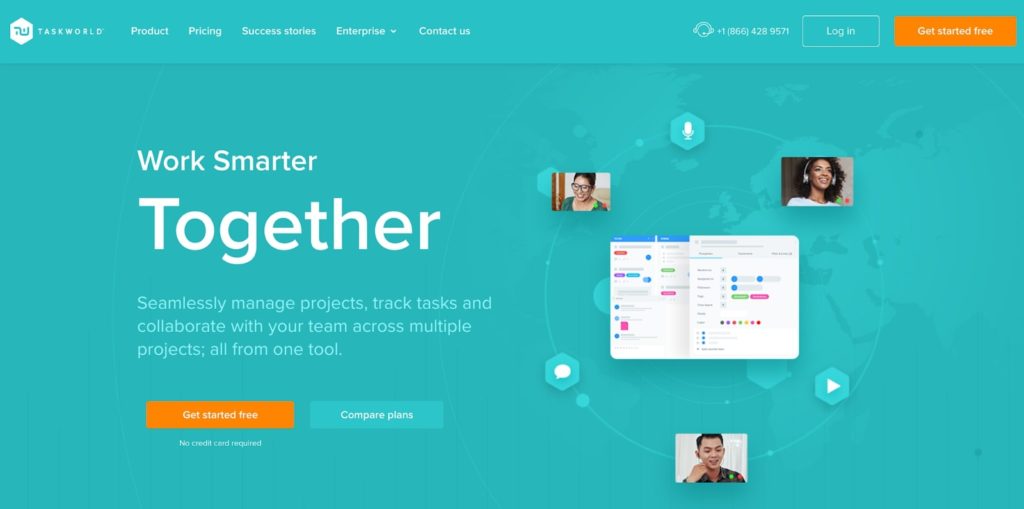
Taskworld is a project management platform for streamlining task tracking and enhancing team collaboration. It features a central Kanban board, built-in chat, and a variety of integrations that keep teams organized and connected as they manage their workflows.
Features
- Manage projects and tasks using Kanban boards and Gantt charts.
- Track time spent on each task.
- Collaborate using file attachments and team messaging.
- Visualize project progress using timelines and reports.
Is Taskworld right for you?
Taskworld has a lot of task management and collaboration features. However, it lacks broader project planning features, so may not be suited to larger project teams.
Pricing
Taskworld does not have a free plan, but offers a 14-day trial. After that, paid plans are $11 per user/mo with a quote-only Enterprise plan for large companies.
Reviews
- “I’ve been using Taskworld for more than four years. Our collaboration makes so much more sense. Organizing our client accounts by projects and consolidating all of our activities in tasks minimizes stress while maximizing productivity and efficiency.” – Verified User, Marketing
- “The interface is no doubt well arranged, but just the thing is that there are various large number of icons and tools all present on the home ages of the software, which makes it confusing for users which software to select.” – Ganesh, Role Unknown
Sciforma
Contact for pricing details
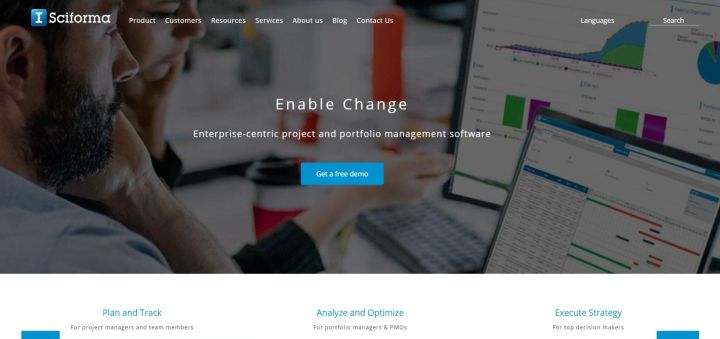
Sciforma is an enterprise project and portfolio management tool designed to boost productivity and make smarter decisions. It’s less focused on day-to-day project and task management, and more on enterprise-level resource management, planning, and strategy alignment.
Features
- Demand management tools to understand and anticipate resource requirements
- Translate strategic organization initiatives into projects and activities
- Create work breakdown structures to manage projects and tasks
- Time and expense tracking
Is Sciforma right for you?
Scirforma works for enterprise users operating at a program or portfolio levels. However, for small teams and projects, it doesn’t give you day-to-day management of deliveries.
Pricing
Scirforma’s website does not provide any pricing details. You need to contact them to request a demo and a price quote.
Reviews
- “Sciforma is easy to use and very efficient in Project Management. It is also very easy to deploy. It is flexible to meet our workflow. It includes many PM methodologies such as waterfall, Agile, Critical Chain Path, and others.” – Philip, Project Manager
- “It is a powerful but complex tool. Long learning curve and sometimes difficult to get my head around — especially when I am unable to find dedicated time to focus on learning and adapting the tool.” – Dwight, User Engagement
Hive
From $5 per user/mo (Free plan available)
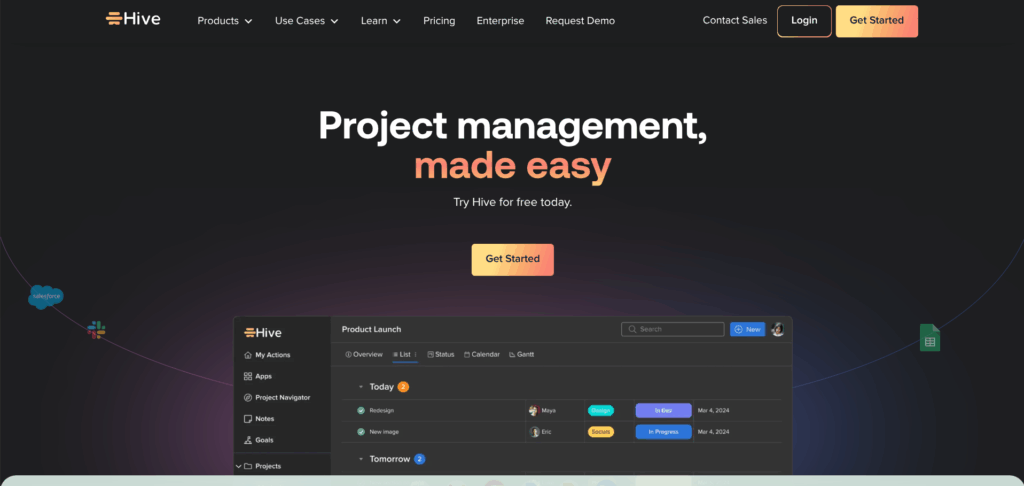
Hive is a simple, yet powerful project management tool that connects teams on projects without complexity. With options for Kanban, Gantt, list, and calendar views, it gives flexibility at a project level, while offering a comprehensive portfolio-level overview.
Features
- Create and manage tasks with kanban, Gantt, list, and calendar views
- Quickly switch between personal and team views
- Monitor performance against business goals
- Use Buzz AI and templates to streamline everyday tasks
Is Hive right for you?
Hive is great for small teams that want an easy, yet flexible tool for managing projects. But it may lack deeper functionality for more complex projects.
Pricing
Hive’s free plan is great for up to 10 users. For additional features or multiple projects, prices start at $5 per user/mo, ranging up to $12 per user/mo for the highest plans.
Reviews
- “Hive features a mostly intuitive UI across browsers and desktop/mobile devices with its Hive App. The service makes tracking project status and related notes effortless, while offering customizable status fields and columns.” – Steven, Broadcast Engineer
- “I’d like to be able to customize my board more. Sometimes the app takes a while to update. It lacks some management-related features, and I can’t insert multimedia content into cards.” – Marco, Marketing Specialist
Airtable
From $20 per user/mo (Free plan available)
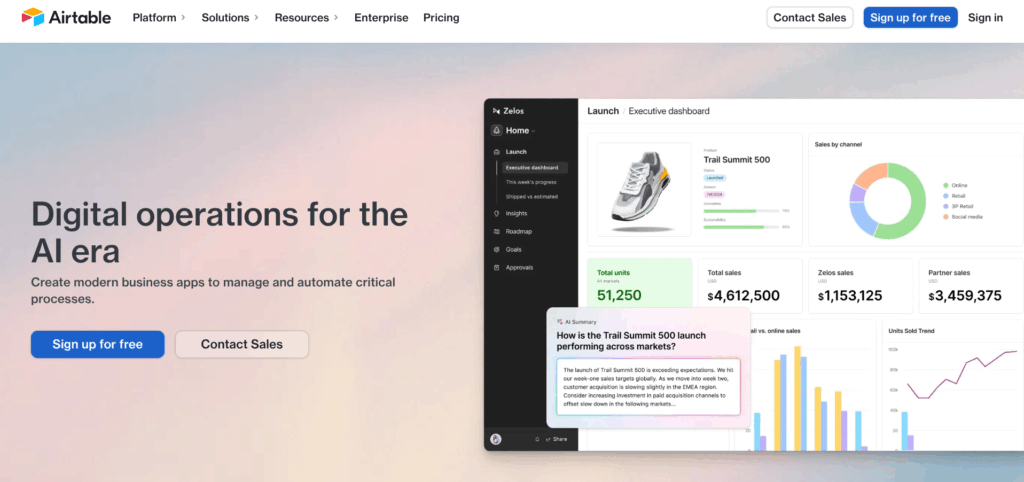
Airtable is a productivity tool that doubles up incredibly well as a flexible project management companion. With features for task and team management, it sets a strong foundation, using its flexible app engine to automate team workflows, report on progress, and manage resources.
Features
- Task management and tracking at project and program level
- Simplify resource management to quickly know who’s working on what
- Automate processes with project templates and workflows
- Build intuitive dashboards to quickly report on the metrics that matter to you
Is Airtable right for you?
Airtable is great for project teams that repeat similar projects time and time again. But if you want more advanced and ‘dedicated’ project management features, alternatives might be easier to get started with.
Pricing
Airtable has a free plan for individuals and small teams of up to five. Plans start from $20 per user/mo, adding Gantt charts, more storage, and integrations.
Reviews
- “Airtable allows you to create workflows and organize data the way you want for your project. This is truly an all-in-one platform with so many features that I haven’t even scratched the surface after months of usage.” – Marc, Video Editor
- “The interface functions still need some work, making them more available and functional on the mobile app. There have also been situations where I can’t quite get the data I need due to Airtable’s limitations.” – Verified User, Non-Profits
Best Free Project Management Tools
Many project management platforms offer free plans, typically with some limitations on features, users, or projects. For freelancers and early-stage startups, these plans often provide just enough to get started. Upgrading to entry-level paid options, often available for under $5 per user/mo, can unlock valuable extras that significantly enhance productivity and collaboration.
Another route? How about open-source project management software, which comes with no subscription fee, although you do have to take care of hosting yourself. This is unlikely to be practical unless you’re an IT professional.
Examples from this guide include Toggl, ClickUp, and Asana.
We have compiled a separate list of the best free project management tools, which may suit your needs if you’re on a limited budget.
Best Web Design Project Management Tools
Web design and development projects are complex. You have to manage client expectations, but still deliver on time and within the allocated budget.
Web design project management software often allows clients to collaborate directly in the tool with you, which can improve relationships and improve the design and concept phases of projects. This is highly beneficial, but often comes at a cost.
Examples from this guide include Toggl, ClickUp, and Asana.
Take a look at the top web design project management tools.
Best Marketing Project Management Tools
Marketing campaigns need precise planning and execution to succeed. Similarly to web design projects, you often need to collaborate with external partners and vendors, too.
Whether you’re an agency or an internal marketing team, you’ll need a project management tool to plan, track, and manage your marketing campaign as well as collaborate with internal and external teams.
Examples from this guide include Toggl, Adobe Workfront, and Basecamp.
We have compiled a list of the best marketing project management tools – check it out.
Best Enterprise Project Management Tools
For an enterprise organization, it’s critical to keep track of all the projects happening across the business. Enterprise project departments, often need more than basic task tracking, and move into the Strategic Portfolio Management (SPM) space. These tools also include:
- The ability to projects, programs, and portfolios.
- Planning and allocating shared resources across projects.
- Alignment of project progress with the organization’s strategy and goals.
- Getting a 360-degree overview of all projects and their dependencies on eachother.
Examples from this guide include Planview, Kantata, Sciforma.
If you’re looking for something similar, take a look at the best enterprise project management tools.
Best Kanban Project Management Tools
Kaban-based project management makes it really easy to visualize the work on your shared to-do list, keeping everyone in the loop on what’s happening now and what’s to come. In addition, Agile software development teams use board-based project management to manage sprints and product backlogs.
Examples from this guide include Trello, Kanban Tool, and monday.com.
Kanban tools come with a simple, visual board that shows your project’s progress. Take a look at the best Kanban project management tools.
Freelance Project Management Tools
Freelancers need light-weight project management. Often freelancers work alone, so they rarely need collaboration features.
But they still need to plan their work and vacation time. In addition, freelancers also use project management software to communicate project progress to clients.
Examples from this guide include Toggl, nTask, and ClickUp.
Take a look at the best freelance project management tools available today.
Choosing A Project Management Tool
There’s no one best project management software. The choice depends on the features you need, your budget, and your project methodology. Whatever you choose, you want to make sure that your team actually enjoys using the software.
Use the tools and filters at the top of this article to shortlist the tools that fit your workflow. Most of these project management tools come with a free plan, just like Toggl Plan, so why not give us a try for free? We promise you won’t regret it!

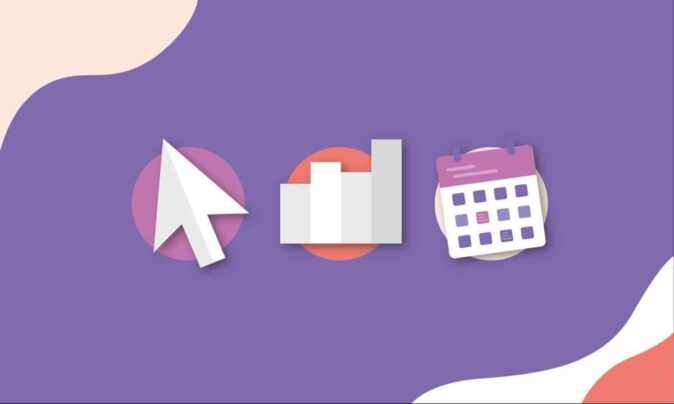
![What is Resource Smoothing in Project Management? [Guide]](https://toggl.com/blog/wp-content/uploads/2023/12/resource-leveling-673x404.jpg)